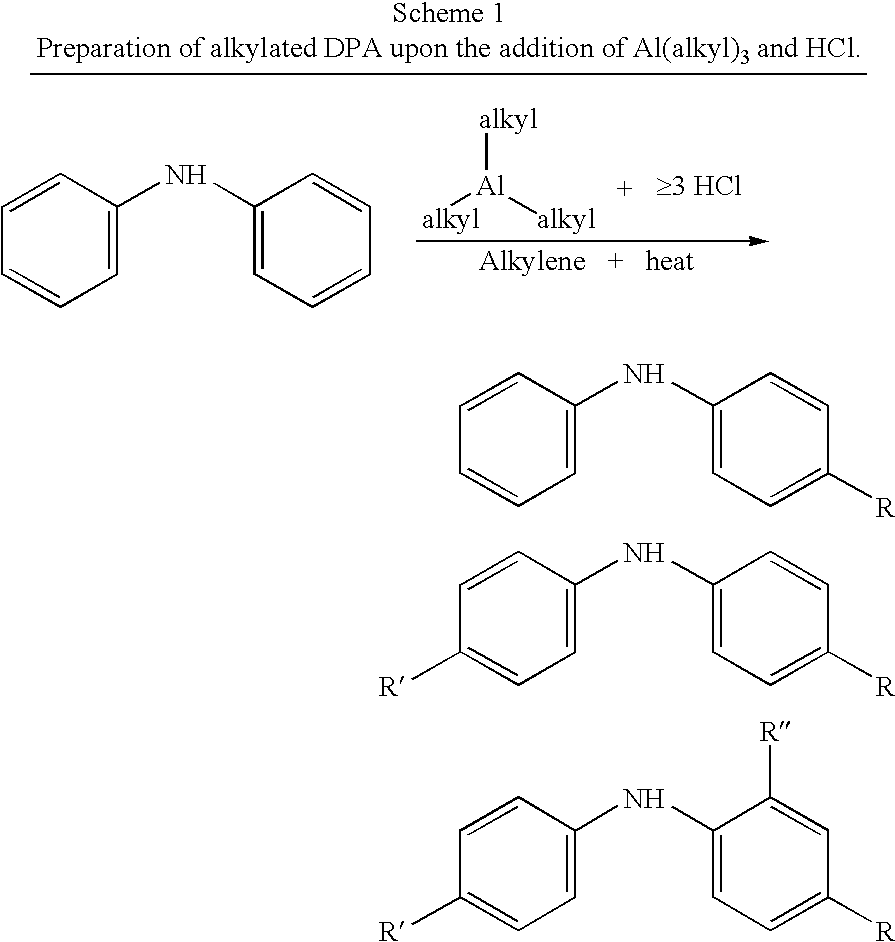Process for synthesizing alkylated arylamines
a technology of alkylated arylamine and process, applied in the field of process for synthesizing alkylated arylamine, can solve the problems of increasing undesirable substitution products, maximizing conversion, and often at the expense of desired product selectivity, so as to maximize conversion, maximize conversion, and maximize the conversion effect of arylamine feedstock
- Summary
- Abstract
- Description
- Claims
- Application Information
AI Technical Summary
Benefits of technology
Problems solved by technology
Method used
Image
Examples
example 1
[0018] The following general procedure was employed to preparation nonylated diphenylamine.
[0019] The reaction glassware was purged with nitrogen before use and the reaction was run under nitrogen. The general molar feed feed ratios are: C9:DPA=2.89; TEA:DPA=0.157; Cl:Al (catalyst)=˜3.3-3.5.
[0020] To a 500 mL boiling flask, 85 g diphenylamine (DPA) was added. The flask was purged with nitrogen for 5 minutes and the flask heated to 60° C. to melt the DPA. To an addition column attached to the flask, 183 g of nonenes (C9) was added. Using appropriate precautions and transfer techniques, 9 g triethylaluminum (TEA) was transferred to the reaction flask, followed immediately by addition of the nonenes from the addition column. After vigorous stirring, the targeted amount of HCl(g) was bubbled through the reaction mixture in the vessel. The reaction was heated at 150° C. for 3 hrs, with samples taken at t=0, 1.5 and 3 hours. The reactor was then cooled and the crude product decanted and...
example 2
[0022] In a dry box, TEA (10 g, 0.088 mol) was charged into 1-1 round bottom flask containing a mixture of 36.0 g (0.28 mol, ˜20% of total required nonenes) of recycled nonenes and 42.0 g (0.33 mol) fresh olefin (total 78 g, ˜0.62 mol). The flask was transferred into a hood and DPA (85.0 g, 0.50 mol) was quickly added and stirred while bubbling HCl under a nitrogen atmosphere. The reactor was equipped with stirring bar, thermocouple and was connected to cooling condenser.
[0023] Approximately 30 g HCl (0.82 mol, Cl / Al ratio ˜9.3) was charged over 10 min and an exotherm (136° C.) was observed. Heating was set at 150° C. When reaction temperature reached 150° C., GC analysis indicated ˜67% conversion of DPA to a mixture of mostly mono-nonylated material. No tri-alkylated product was formed.
[0024] The balance of the required 2.9 equivalent of nonenes (105 g fresh olefins, 0.83 mol, ˜183 g total charged nonenes, ˜2.9 equivalents) was then added over 17 min while heating at 150° C. Afte...
example 3
[0028] TEA (7.0 g, 61 mmol) was charged into 1-1 round bottom flask (equipped with magnetic stirrer, thermocouple, and cooling condenser) containing 120 g (0.95 mol) nonenes. Solid DPA (85 g, 0.50 mol) was added to the nonene / TEA mixture and the slurry was stirred while bubbling HCl under a nitrogen atmosphere.
[0029] Approximately 11.7 g HCl (0.32 mol, Cl / Al ratio ˜5.2) was charged over 15 min and heating temperature was set at 125° C. GC analysis indicated 88% DPA conversion to products in less than 2 hours of heating. The third equivalent of nonenes was added (61 g, total 181 g) and the reaction progress was monitored and summarized as shown Table 3. A total of fifteen hours of heating, after addition of all nonenes, was necessary for >99% DPA conversion.
[0030] The crude reaction mass was poured slowly over 125 g of 25 wt. % caustic solution, in a separate 1-L round bottom flask equipped with mechanical stirrer and was vigorously mixed (320 rpm, 25 min) and the two phases were a...
PUM
| Property | Measurement | Unit |
|---|---|---|
| temperature | aaaaa | aaaaa |
| reaction temperature | aaaaa | aaaaa |
| reaction temperature | aaaaa | aaaaa |
Abstract
Description
Claims
Application Information
 Login to View More
Login to View More - R&D
- Intellectual Property
- Life Sciences
- Materials
- Tech Scout
- Unparalleled Data Quality
- Higher Quality Content
- 60% Fewer Hallucinations
Browse by: Latest US Patents, China's latest patents, Technical Efficacy Thesaurus, Application Domain, Technology Topic, Popular Technical Reports.
© 2025 PatSnap. All rights reserved.Legal|Privacy policy|Modern Slavery Act Transparency Statement|Sitemap|About US| Contact US: help@patsnap.com

